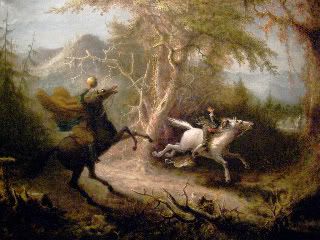The Folklore of Ghosts and Hauntings
Ghosts and Folklore
Ghosts are perhaps the most controversial and widely reported of all unexplained phenomena. But although ghostly visitors are sighted in their thousands all over the world and ‘true’ ghost tales are hugely popular, the whole subject of ghost lore is widely misinterpreted and misunderstood. The majority of people are familiar with at least one local or national ghost story but the role of folklore, folk tales and urban legend in connection with the supernatural is rarely touched upon outside of academic journals. But the connection between folklore and allegedly true accounts of the supernatural is an important and extremely relevant one.
 Does this mean then that we can interpret the endless streams of headless horsemen, phantom nuns and monks, spectral armies, ghostly Roman legionaries, vanishing hitchhikers, black dogs and white ladies as figures of folklore and urban legend rather than physical reality?
Does this mean then that we can interpret the endless streams of headless horsemen, phantom nuns and monks, spectral armies, ghostly Roman legionaries, vanishing hitchhikers, black dogs and white ladies as figures of folklore and urban legend rather than physical reality?
Perhaps this is to oversimplify a complex phenomenon, but certainly the development of folk beliefs over the centuries has affected the way in which we report and interpret ghostly phenomena.
The History of Ghost Lore
Every culture has its own particular kind of ghost lore, some, like England, have a history of phantom reports stretching back to pre-Medieval times. Generally, ‘true’ accounts of ghosts and hauntings can be dated back at least as far as Classical Greece (5th – 4th centuries BC) and the genre shows no signs of waning in the 21st century.
But what exactly is a ghost? In general the term is used to describe the appearance of the souls or spirits of the dead before the living, while the word ‘haunting’ signifies the recurring manifestation of a ghost witnessed by someone in a certain location. A ghost is usually described as similar in appearance, if not identical, to the dead person when they were living. However, not all hauntings involve apparitions, they may be auditory (relating to the sense of hearing) or olfactory (relating to the sense of smell), types of phenomena most frequently reported in poltergeist cases.
But even with such apparently safe definitions we are not always on sure ground. As Owen Davies points out in his authoritative The Haunted: A Social History of Ghosts (2007), in the past it was fairies that were believed to haunt certain locations, which would seem to indicate an origin in folklore and legend for the idea of haunted spots. Writing in his classic work on fairy lore The Secret Commonwealth of Elves, Fauns, and Fairies (1661) the Scottish antiquarian the Reverend Robert Kirk noted that it was a popular idea among some people at the time that fairies were the souls of the dead that remained on earth.
Indeed looking at accounts of hauntings from the 16th to 18th centuries it is notable that ghosts, fairies, angels and demons exhibit extremely similar characteristics. It was usually only the context in which they appeared which allowed them to be identified as one or the other.
Why are Ghosts Reported?
There have been a number of reasons put forward for why the spirits of the dead would want to haunt the living. Before the Reformation in England (during the reign of Henry VIII, 1509 to 1547) many ghosts returned to request masses to be said for their souls, bemoaning the fact that they could not otherwise enter heaven. In later centuries someone might come back as a ghost because their personal affairs had been left in confusion when they died.




